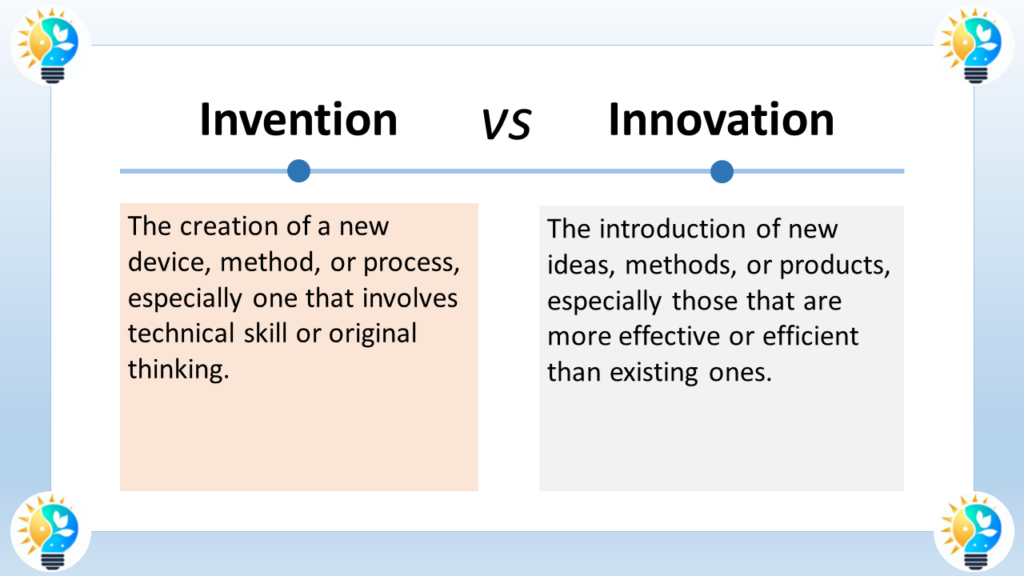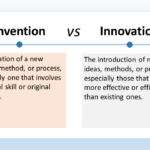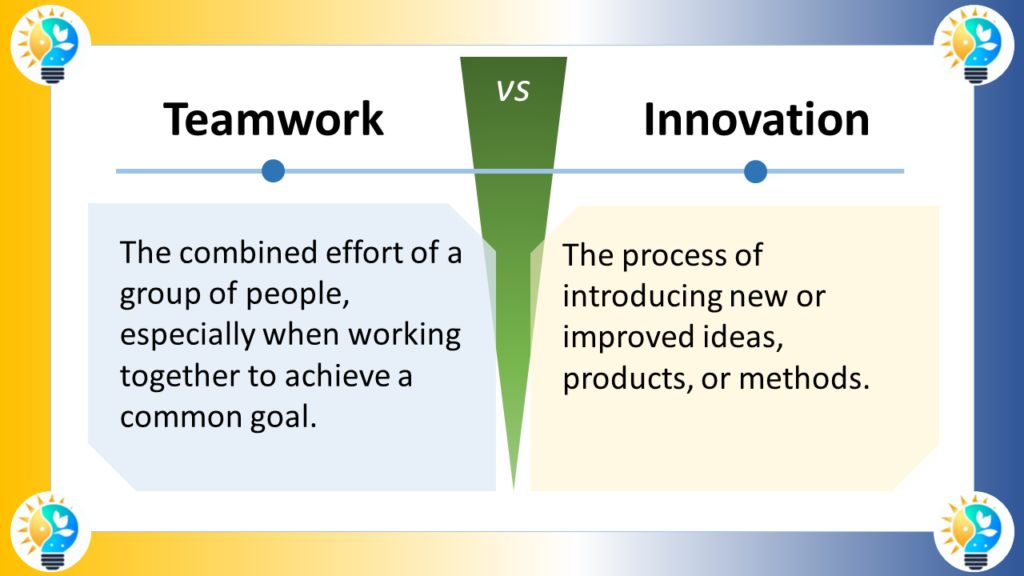
Invention and innovation are closely related but differ in scope.
Invention focuses on creating new devices or methods, often requiring technical expertise or originality.
Innovation encompasses the broader process of implementing these inventions into practical use, driving progress and change within societies or industries through the adoption of inventive solutions.
When it comes to the world of business and technology, innovation and invention are two terms that are often wrongly used interchangeably.
Innovation vs Invention
Definitions
Innovation refers to the process of introducing new ideas, products, or methods into an existing system or market. It can involve making improvements to existing products or processes, or developing entirely new ones. Innovation is often driven by a desire to solve a problem or meet a need that is not currently being met. It requires creativity, risk-taking, and a willingness to experiment and learn from failures. Innovation can have a significant impact on businesses, industries, and society as a whole, as it can lead to new opportunities, increased efficiency, and improved quality of life.
An invention is a new product, process, or idea that has never been created or used before. It is the result of a creative and inventive process that involves identifying a need or problem, generating ideas, and developing a solution. Inventions can range from simple tools and devices to complex technologies and systems. They can have a significant impact on society, as they can improve the way we live, work, and interact with each other. Inventions can also have economic value, as they can be patented and licensed to generate revenue. However, not all inventions result in successful innovations, as they may not be practical, feasible, or meet a market need.
More Synonyms on innovation, innovate and innovative
Innovation Terms

Innovation is considered as a driving force in progress.
It includes the introduction of novel ideas, methods, or products that bring positive change and advancement.
For more information about innovations, check our glossary
The difference between invention and innovation
The difference between invention and innovation lies in their impact and nature. An invention is the creation of something entirely new, while innovation involves refining, adapting, and introducing changes to existing ideas or methods to make them useful or impactful. In other words, invention is about creating something new, while innovation is about the use and impact of an idea or method.
In summary:
- Invention: The creation of something entirely new.
- Innovation: Refining, adapting, and introducing changes to existing ideas or methods to make them useful or impactful.
Invention: Creation of Something New
An invention is the creation of a new product, process, or idea that has never existed before. It involves a significant amount of research, development, and testing to ensure that the invention is practical, functional, and meets a specific need or solves a problem. Inventions can come from individuals or teams of people, and they can be protected by patents to prevent others from copying or selling them without permission.
Innovation: Implementing New Ideas
On the other hand, innovation is the process of implementing new ideas, products, or processes in a way that adds value or improves upon existing solutions. Innovation can involve taking an existing invention and finding new applications or markets for it, or it can involve creating entirely new products or services. Innovation is about finding new and better ways to do things, and it often involves a combination of creativity, problem-solving, and risk-taking.
The Relationship Between Innovation and Invention
While invention and innovation are distinct concepts, they are closely related. In many cases, innovation is built upon invention.
A new invention creates the possibility for innovation by providing a new tool, technology, or idea that can be used to solve problems or create new opportunities. However, it is important to note that not all inventions lead to innovation. An invention may be impractical, too expensive, or not meet a market need, and therefore not be adopted or commercialized.
Innovation can also lead to invention. When companies or individuals identify a need or opportunity, they may invest in research and development to create a new invention that meets that need. This is often seen in industries such as technology, where rapid innovation drives the development of new products and services.
To Invent vs To Innovate
Definitions:
To Invent
To invent means to conceive an original idea, device, or process through creative thinking. The act of inventing involves:
- Conceptualizing novel technological or design solutions
- Developing prototypes and proof-of-concept models
- Pursuing patents to protect intellectual property
To Innovate
To innovate differs from inventing as it refers to the process of refining, improving and implementing inventions. The act of innovating involves:
- Enhancing, updating and commercializing invented technologies
- Developing new business models and distribution methods
- Driving customer adoption through marketing and sales
The Link Between Inventing and Innovating
While inventing generates new concepts, innovating transforms those concepts into usable solutions. To invent is to spark novel ideas, but true progress requires innovating to fans those sparks into sustainable businesses.<sup>[1]</sup> Many renowned innovators like Edison, Jobs, and Musk also invented foundational technologies.
However, innovation can occur without direct invention by reimagining what exists. Either way, sustained cycles of inventing and innovating are needed to move industries and economies forward over the long run.
The Outcomes of Inventing and Innovating
The outcomes of these processes also differ. Inventing establishes new technologies or approaches. But it is innovating that implements those foundations and drives major changes like new industries, jobs and economic growth.<sup>[2]</sup> Countries relying only on invention risk slow development, while those fostering both see faster transformation.
Within firms, invention seeds new products, but consistent innovating refines them for customers and scales their impact on markets. Stagnating innovators lose opportunities, while disruptive innovators reshape entire sectors through iterative invention and refinement.
Innovation and Invention in Business
In the world of business, innovation and invention are critical for success. Companies that are able to innovate and bring new products and services to market are more likely to grow and stay competitive. Innovation can also help companies to differentiate themselves from their competitors, and create new revenue streams.
Invention is also important for businesses, particularly in industries that rely on new technologies or products. Companies that are able to create new patents and protect their intellectual property are more likely to maintain a competitive advantage and generate revenue from their inventions.
The Role of Innovation and Invention in Society
Innovation and invention are not just important for businesses, but also for society as a whole. They drive progress and improve the quality of life for people around the world. Innovations in healthcare, transportation, communication, and other fields have transformed the way we live, work, and interact with each other.
Invention is also important for addressing global challenges such as climate change, poverty, and inequality. By creating new technologies and solutions, we can address these challenges in more effective and sustainable ways.
Conclusion
In conclusion, while invention and innovation are distinct concepts, they are closely related and often overlap. Invention involves the creation of something new, while innovation involves the implementation of new ideas in a way that adds value or improves upon existing solutions. Both are critical for success in business and for driving progress in society. By understanding the relationship between innovation and invention, we can better harness their power to create positive change in the world.


